BABS - Tesco PLC's Financial Reports: Meeting External User Needs
VerifiedAdded on 2023/06/13
|17
|3845
|183
Report
AI Summary
This report examines how Tesco PLC's financial information caters to its non-management external users, including potential investors, trade creditors, lenders, tax authorities, regulatory agencies, and customers. It details how these users leverage annual reports and financial statements to assess the company's financial health, creditworthiness, investment potential, and regulatory compliance. The report analyzes key financial ratios like gross margin, net margin, return on assets, return on equity, and current ratios, demonstrating how these metrics inform stakeholder decisions regarding investment, credit terms, and long-term business relationships. The study highlights the importance of transparent financial reporting in maintaining stakeholder confidence and facilitating informed decision-making.
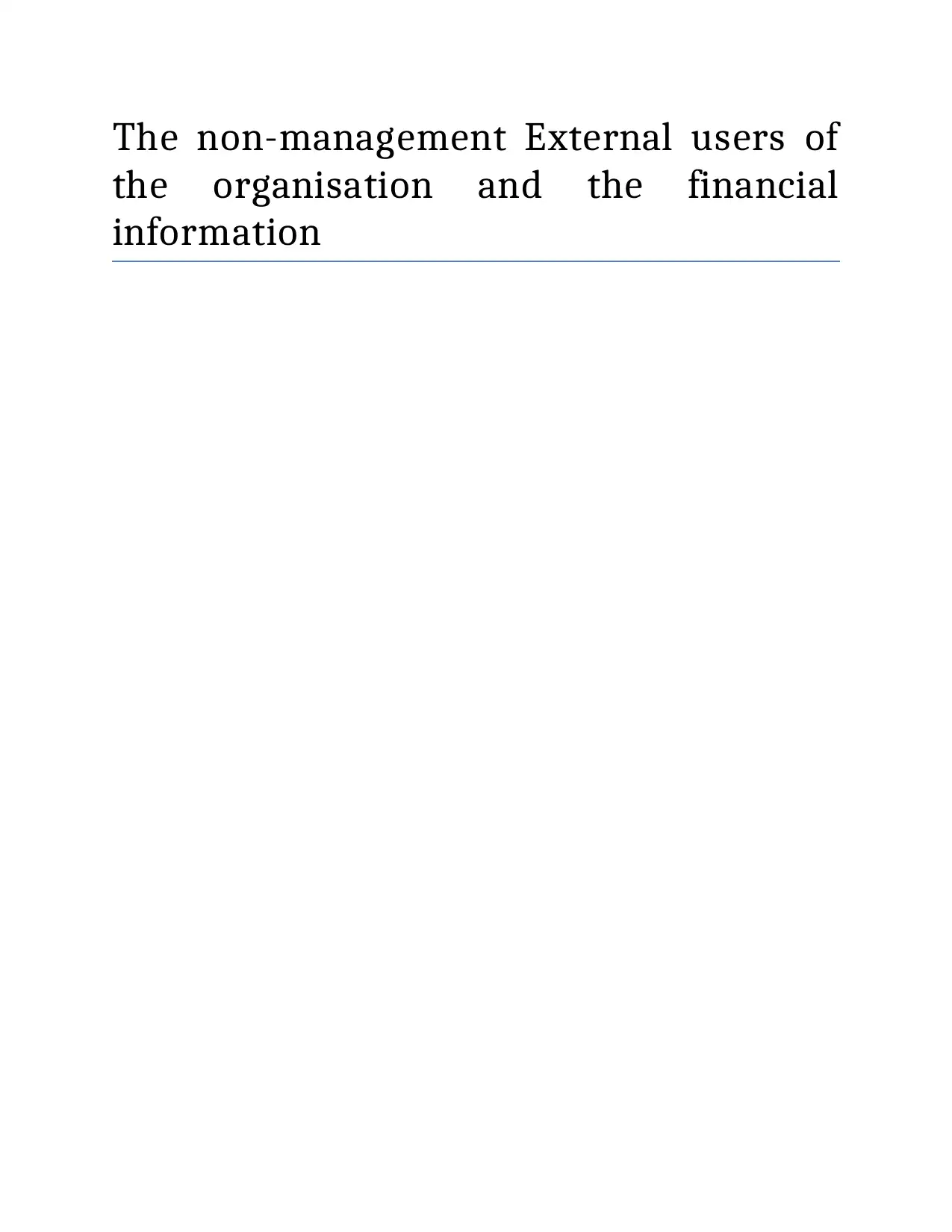
The non-management External users of
the organisation and the financial
information
the organisation and the financial
information
Paraphrase This Document
Need a fresh take? Get an instant paraphrase of this document with our AI Paraphraser
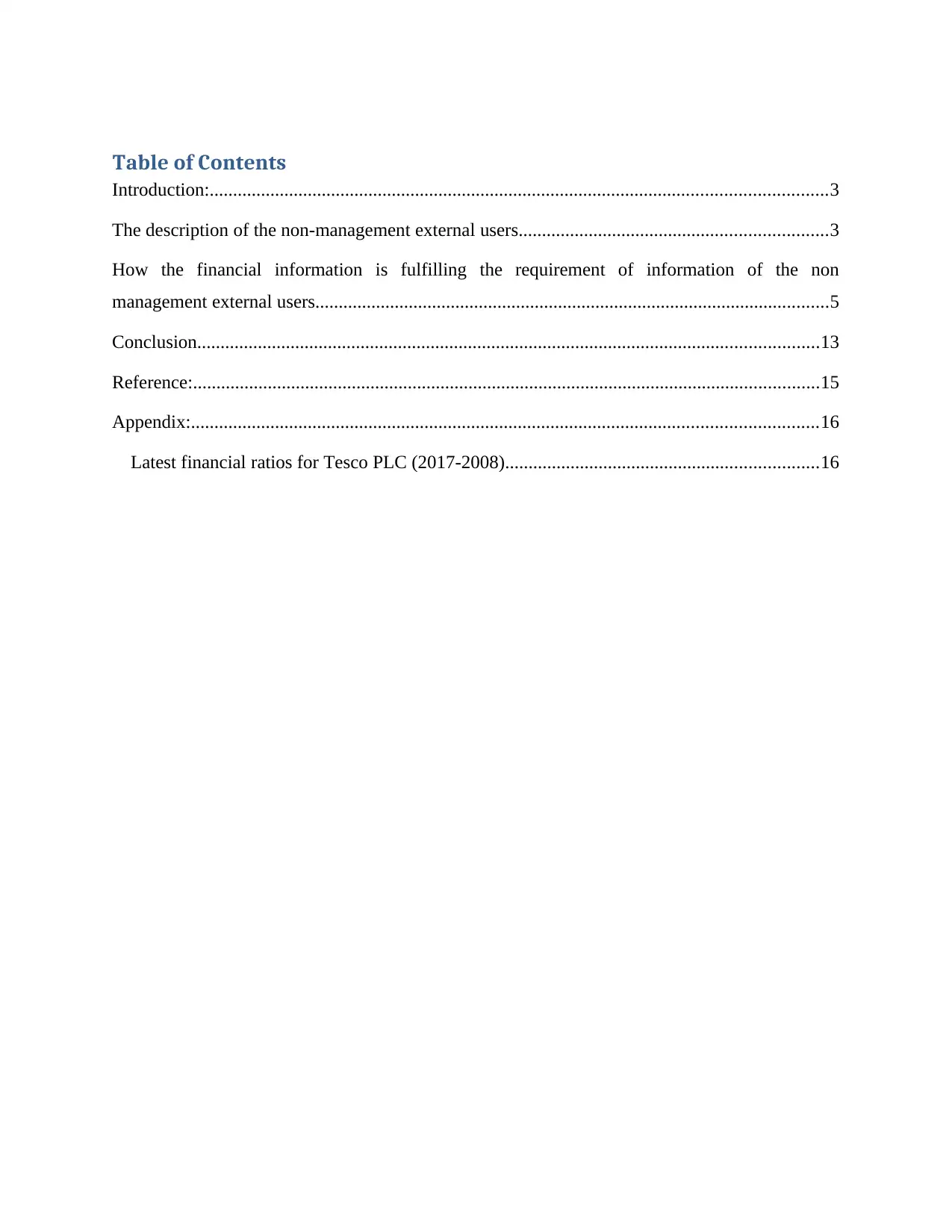
Table of Contents
Introduction:....................................................................................................................................3
The description of the non-management external users..................................................................3
How the financial information is fulfilling the requirement of information of the non
management external users..............................................................................................................5
Conclusion.....................................................................................................................................13
Reference:......................................................................................................................................15
Appendix:......................................................................................................................................16
Latest financial ratios for Tesco PLC (2017-2008)...................................................................16
Introduction:....................................................................................................................................3
The description of the non-management external users..................................................................3
How the financial information is fulfilling the requirement of information of the non
management external users..............................................................................................................5
Conclusion.....................................................................................................................................13
Reference:......................................................................................................................................15
Appendix:......................................................................................................................................16
Latest financial ratios for Tesco PLC (2017-2008)...................................................................16
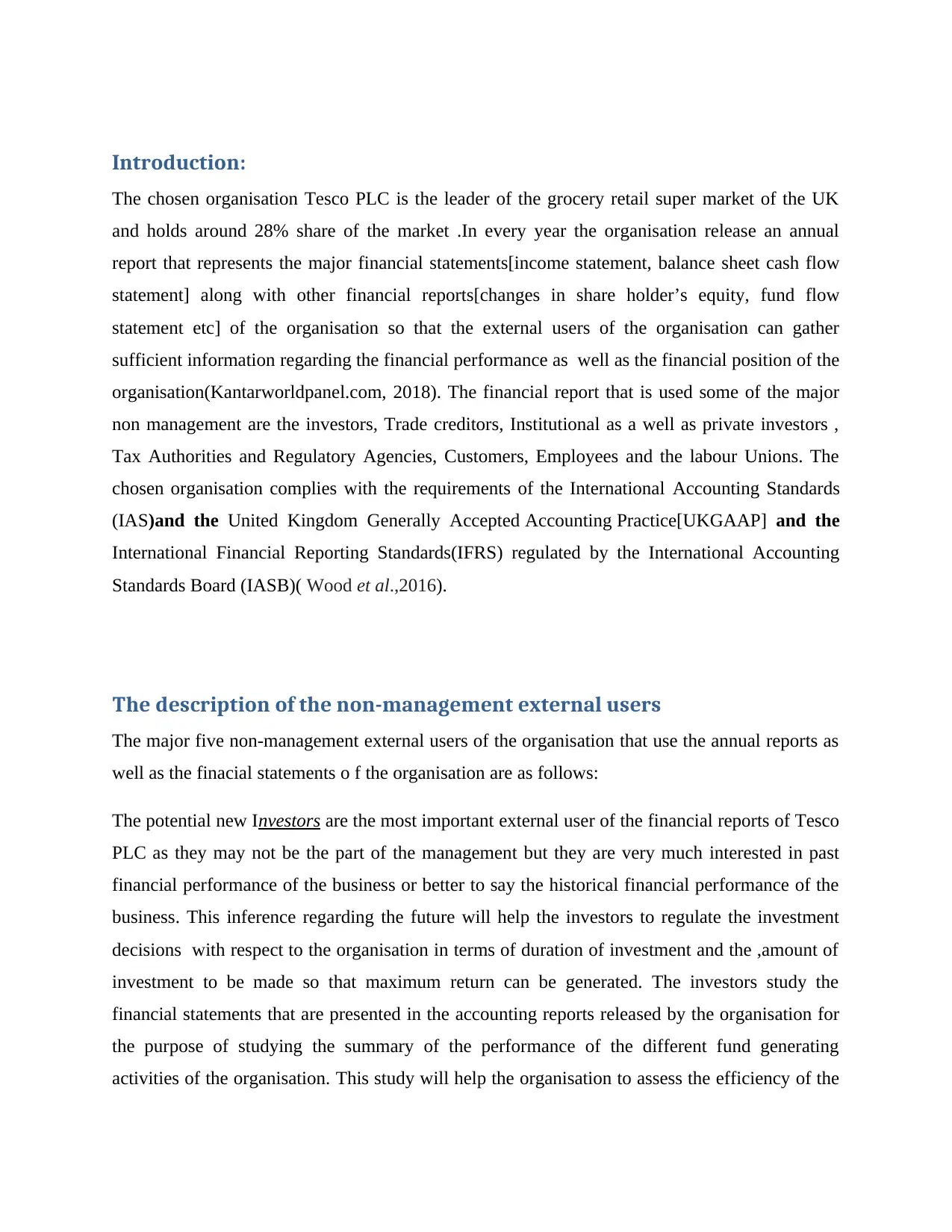
Introduction:
The chosen organisation Tesco PLC is the leader of the grocery retail super market of the UK
and holds around 28% share of the market .In every year the organisation release an annual
report that represents the major financial statements[income statement, balance sheet cash flow
statement] along with other financial reports[changes in share holder’s equity, fund flow
statement etc] of the organisation so that the external users of the organisation can gather
sufficient information regarding the financial performance as well as the financial position of the
organisation(Kantarworldpanel.com, 2018). The financial report that is used some of the major
non management are the investors, Trade creditors, Institutional as a well as private investors ,
Tax Authorities and Regulatory Agencies, Customers, Employees and the labour Unions. The
chosen organisation complies with the requirements of the International Accounting Standards
(IAS)and the United Kingdom Generally Accepted Accounting Practice[UKGAAP] and the
International Financial Reporting Standards(IFRS) regulated by the International Accounting
Standards Board (IASB)( Wood et al.,2016).
The description of the non-management external users
The major five non-management external users of the organisation that use the annual reports as
well as the finacial statements o f the organisation are as follows:
The potential new Investors are the most important external user of the financial reports of Tesco
PLC as they may not be the part of the management but they are very much interested in past
financial performance of the business or better to say the historical financial performance of the
business. This inference regarding the future will help the investors to regulate the investment
decisions with respect to the organisation in terms of duration of investment and the ,amount of
investment to be made so that maximum return can be generated. The investors study the
financial statements that are presented in the accounting reports released by the organisation for
the purpose of studying the summary of the performance of the different fund generating
activities of the organisation. This study will help the organisation to assess the efficiency of the
The chosen organisation Tesco PLC is the leader of the grocery retail super market of the UK
and holds around 28% share of the market .In every year the organisation release an annual
report that represents the major financial statements[income statement, balance sheet cash flow
statement] along with other financial reports[changes in share holder’s equity, fund flow
statement etc] of the organisation so that the external users of the organisation can gather
sufficient information regarding the financial performance as well as the financial position of the
organisation(Kantarworldpanel.com, 2018). The financial report that is used some of the major
non management are the investors, Trade creditors, Institutional as a well as private investors ,
Tax Authorities and Regulatory Agencies, Customers, Employees and the labour Unions. The
chosen organisation complies with the requirements of the International Accounting Standards
(IAS)and the United Kingdom Generally Accepted Accounting Practice[UKGAAP] and the
International Financial Reporting Standards(IFRS) regulated by the International Accounting
Standards Board (IASB)( Wood et al.,2016).
The description of the non-management external users
The major five non-management external users of the organisation that use the annual reports as
well as the finacial statements o f the organisation are as follows:
The potential new Investors are the most important external user of the financial reports of Tesco
PLC as they may not be the part of the management but they are very much interested in past
financial performance of the business or better to say the historical financial performance of the
business. This inference regarding the future will help the investors to regulate the investment
decisions with respect to the organisation in terms of duration of investment and the ,amount of
investment to be made so that maximum return can be generated. The investors study the
financial statements that are presented in the accounting reports released by the organisation for
the purpose of studying the summary of the performance of the different fund generating
activities of the organisation. This study will help the organisation to assess the efficiency of the
⊘ This is a preview!⊘
Do you want full access?
Subscribe today to unlock all pages.

Trusted by 1+ million students worldwide
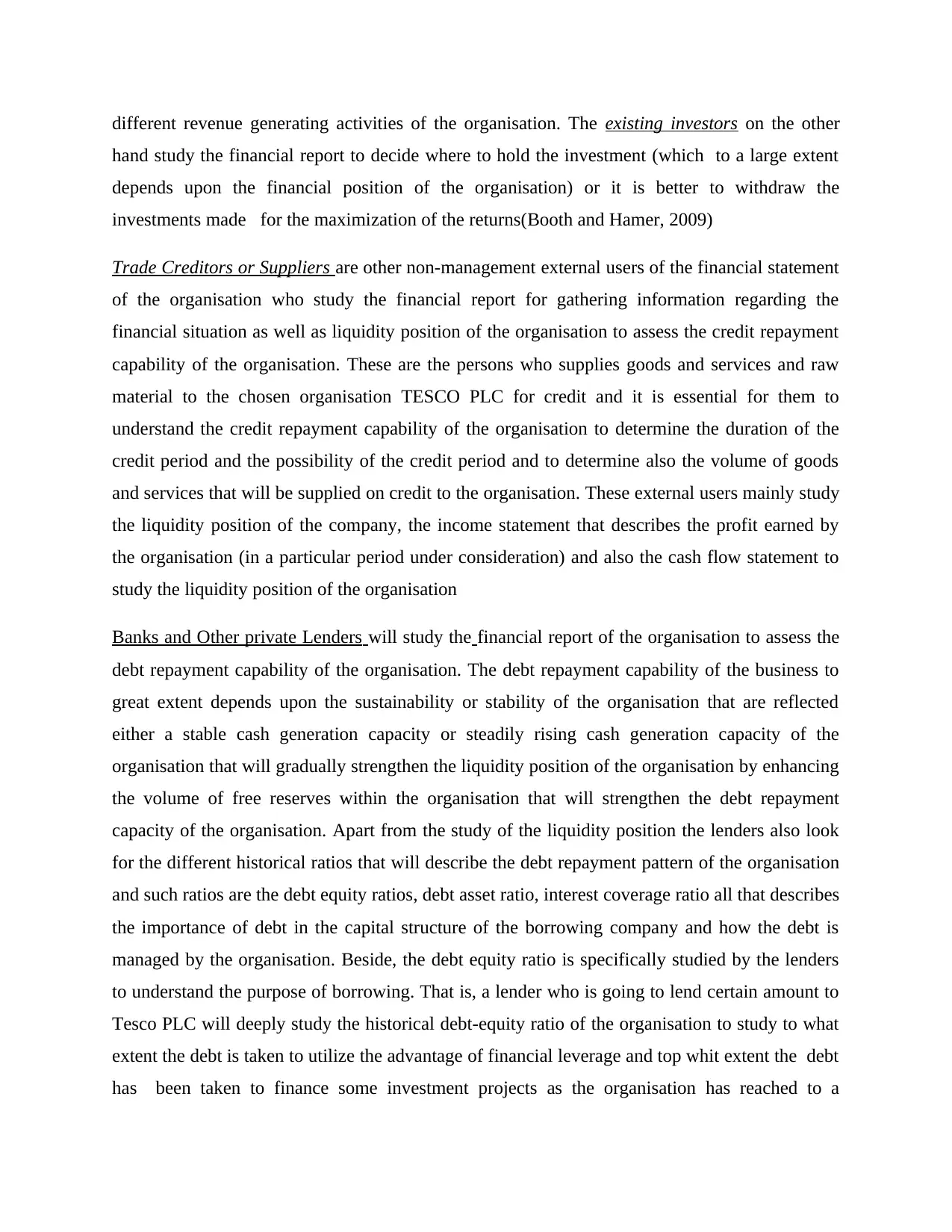
different revenue generating activities of the organisation. The existing investors on the other
hand study the financial report to decide where to hold the investment (which to a large extent
depends upon the financial position of the organisation) or it is better to withdraw the
investments made for the maximization of the returns(Booth and Hamer, 2009)
Trade Creditors or Suppliers are other non-management external users of the financial statement
of the organisation who study the financial report for gathering information regarding the
financial situation as well as liquidity position of the organisation to assess the credit repayment
capability of the organisation. These are the persons who supplies goods and services and raw
material to the chosen organisation TESCO PLC for credit and it is essential for them to
understand the credit repayment capability of the organisation to determine the duration of the
credit period and the possibility of the credit period and to determine also the volume of goods
and services that will be supplied on credit to the organisation. These external users mainly study
the liquidity position of the company, the income statement that describes the profit earned by
the organisation (in a particular period under consideration) and also the cash flow statement to
study the liquidity position of the organisation
Banks and Other private Lenders will study the financial report of the organisation to assess the
debt repayment capability of the organisation. The debt repayment capability of the business to
great extent depends upon the sustainability or stability of the organisation that are reflected
either a stable cash generation capacity or steadily rising cash generation capacity of the
organisation that will gradually strengthen the liquidity position of the organisation by enhancing
the volume of free reserves within the organisation that will strengthen the debt repayment
capacity of the organisation. Apart from the study of the liquidity position the lenders also look
for the different historical ratios that will describe the debt repayment pattern of the organisation
and such ratios are the debt equity ratios, debt asset ratio, interest coverage ratio all that describes
the importance of debt in the capital structure of the borrowing company and how the debt is
managed by the organisation. Beside, the debt equity ratio is specifically studied by the lenders
to understand the purpose of borrowing. That is, a lender who is going to lend certain amount to
Tesco PLC will deeply study the historical debt-equity ratio of the organisation to study to what
extent the debt is taken to utilize the advantage of financial leverage and top whit extent the debt
has been taken to finance some investment projects as the organisation has reached to a
hand study the financial report to decide where to hold the investment (which to a large extent
depends upon the financial position of the organisation) or it is better to withdraw the
investments made for the maximization of the returns(Booth and Hamer, 2009)
Trade Creditors or Suppliers are other non-management external users of the financial statement
of the organisation who study the financial report for gathering information regarding the
financial situation as well as liquidity position of the organisation to assess the credit repayment
capability of the organisation. These are the persons who supplies goods and services and raw
material to the chosen organisation TESCO PLC for credit and it is essential for them to
understand the credit repayment capability of the organisation to determine the duration of the
credit period and the possibility of the credit period and to determine also the volume of goods
and services that will be supplied on credit to the organisation. These external users mainly study
the liquidity position of the company, the income statement that describes the profit earned by
the organisation (in a particular period under consideration) and also the cash flow statement to
study the liquidity position of the organisation
Banks and Other private Lenders will study the financial report of the organisation to assess the
debt repayment capability of the organisation. The debt repayment capability of the business to
great extent depends upon the sustainability or stability of the organisation that are reflected
either a stable cash generation capacity or steadily rising cash generation capacity of the
organisation that will gradually strengthen the liquidity position of the organisation by enhancing
the volume of free reserves within the organisation that will strengthen the debt repayment
capacity of the organisation. Apart from the study of the liquidity position the lenders also look
for the different historical ratios that will describe the debt repayment pattern of the organisation
and such ratios are the debt equity ratios, debt asset ratio, interest coverage ratio all that describes
the importance of debt in the capital structure of the borrowing company and how the debt is
managed by the organisation. Beside, the debt equity ratio is specifically studied by the lenders
to understand the purpose of borrowing. That is, a lender who is going to lend certain amount to
Tesco PLC will deeply study the historical debt-equity ratio of the organisation to study to what
extent the debt is taken to utilize the advantage of financial leverage and top whit extent the debt
has been taken to finance some investment projects as the organisation has reached to a
Paraphrase This Document
Need a fresh take? Get an instant paraphrase of this document with our AI Paraphraser
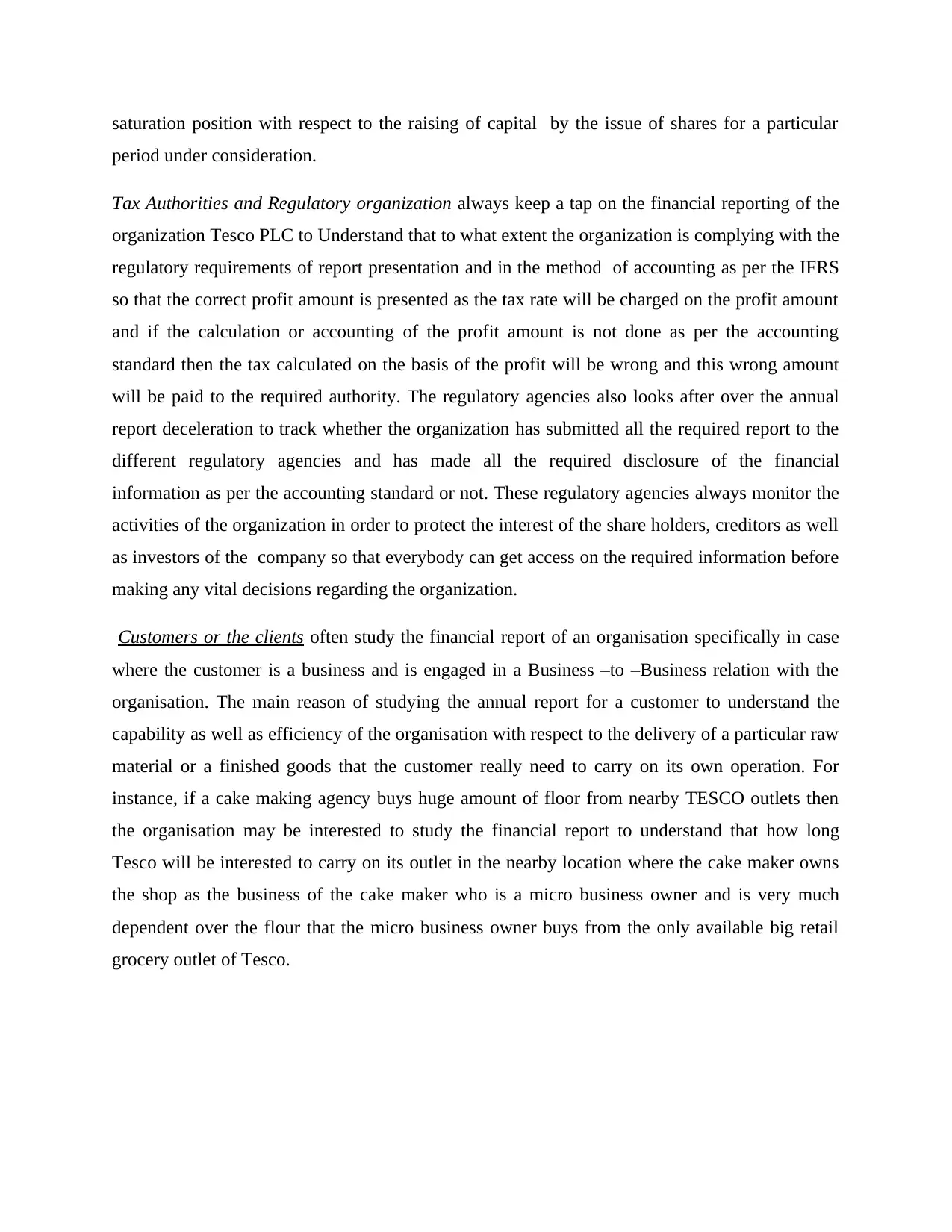
saturation position with respect to the raising of capital by the issue of shares for a particular
period under consideration.
Tax Authorities and Regulatory organization always keep a tap on the financial reporting of the
organization Tesco PLC to Understand that to what extent the organization is complying with the
regulatory requirements of report presentation and in the method of accounting as per the IFRS
so that the correct profit amount is presented as the tax rate will be charged on the profit amount
and if the calculation or accounting of the profit amount is not done as per the accounting
standard then the tax calculated on the basis of the profit will be wrong and this wrong amount
will be paid to the required authority. The regulatory agencies also looks after over the annual
report deceleration to track whether the organization has submitted all the required report to the
different regulatory agencies and has made all the required disclosure of the financial
information as per the accounting standard or not. These regulatory agencies always monitor the
activities of the organization in order to protect the interest of the share holders, creditors as well
as investors of the company so that everybody can get access on the required information before
making any vital decisions regarding the organization.
Customers or the clients often study the financial report of an organisation specifically in case
where the customer is a business and is engaged in a Business –to –Business relation with the
organisation. The main reason of studying the annual report for a customer to understand the
capability as well as efficiency of the organisation with respect to the delivery of a particular raw
material or a finished goods that the customer really need to carry on its own operation. For
instance, if a cake making agency buys huge amount of floor from nearby TESCO outlets then
the organisation may be interested to study the financial report to understand that how long
Tesco will be interested to carry on its outlet in the nearby location where the cake maker owns
the shop as the business of the cake maker who is a micro business owner and is very much
dependent over the flour that the micro business owner buys from the only available big retail
grocery outlet of Tesco.
period under consideration.
Tax Authorities and Regulatory organization always keep a tap on the financial reporting of the
organization Tesco PLC to Understand that to what extent the organization is complying with the
regulatory requirements of report presentation and in the method of accounting as per the IFRS
so that the correct profit amount is presented as the tax rate will be charged on the profit amount
and if the calculation or accounting of the profit amount is not done as per the accounting
standard then the tax calculated on the basis of the profit will be wrong and this wrong amount
will be paid to the required authority. The regulatory agencies also looks after over the annual
report deceleration to track whether the organization has submitted all the required report to the
different regulatory agencies and has made all the required disclosure of the financial
information as per the accounting standard or not. These regulatory agencies always monitor the
activities of the organization in order to protect the interest of the share holders, creditors as well
as investors of the company so that everybody can get access on the required information before
making any vital decisions regarding the organization.
Customers or the clients often study the financial report of an organisation specifically in case
where the customer is a business and is engaged in a Business –to –Business relation with the
organisation. The main reason of studying the annual report for a customer to understand the
capability as well as efficiency of the organisation with respect to the delivery of a particular raw
material or a finished goods that the customer really need to carry on its own operation. For
instance, if a cake making agency buys huge amount of floor from nearby TESCO outlets then
the organisation may be interested to study the financial report to understand that how long
Tesco will be interested to carry on its outlet in the nearby location where the cake maker owns
the shop as the business of the cake maker who is a micro business owner and is very much
dependent over the flour that the micro business owner buys from the only available big retail
grocery outlet of Tesco.
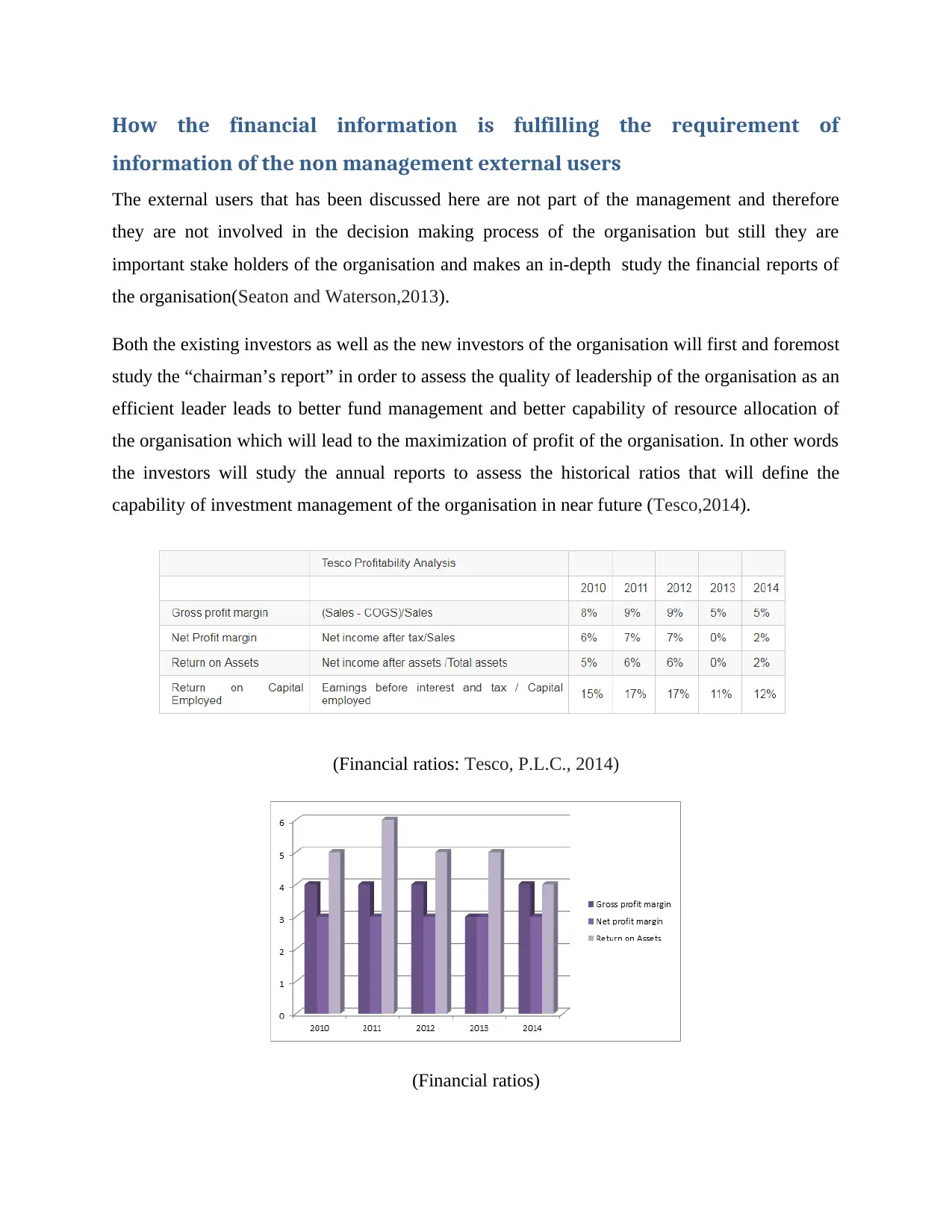
How the financial information is fulfilling the requirement of
information of the non management external users
The external users that has been discussed here are not part of the management and therefore
they are not involved in the decision making process of the organisation but still they are
important stake holders of the organisation and makes an in-depth study the financial reports of
the organisation(Seaton and Waterson,2013).
Both the existing investors as well as the new investors of the organisation will first and foremost
study the “chairman’s report” in order to assess the quality of leadership of the organisation as an
efficient leader leads to better fund management and better capability of resource allocation of
the organisation which will lead to the maximization of profit of the organisation. In other words
the investors will study the annual reports to assess the historical ratios that will define the
capability of investment management of the organisation in near future (Tesco,2014).
(Financial ratios: Tesco, P.L.C., 2014)
(Financial ratios)
information of the non management external users
The external users that has been discussed here are not part of the management and therefore
they are not involved in the decision making process of the organisation but still they are
important stake holders of the organisation and makes an in-depth study the financial reports of
the organisation(Seaton and Waterson,2013).
Both the existing investors as well as the new investors of the organisation will first and foremost
study the “chairman’s report” in order to assess the quality of leadership of the organisation as an
efficient leader leads to better fund management and better capability of resource allocation of
the organisation which will lead to the maximization of profit of the organisation. In other words
the investors will study the annual reports to assess the historical ratios that will define the
capability of investment management of the organisation in near future (Tesco,2014).
(Financial ratios: Tesco, P.L.C., 2014)
(Financial ratios)
⊘ This is a preview!⊘
Do you want full access?
Subscribe today to unlock all pages.

Trusted by 1+ million students worldwide
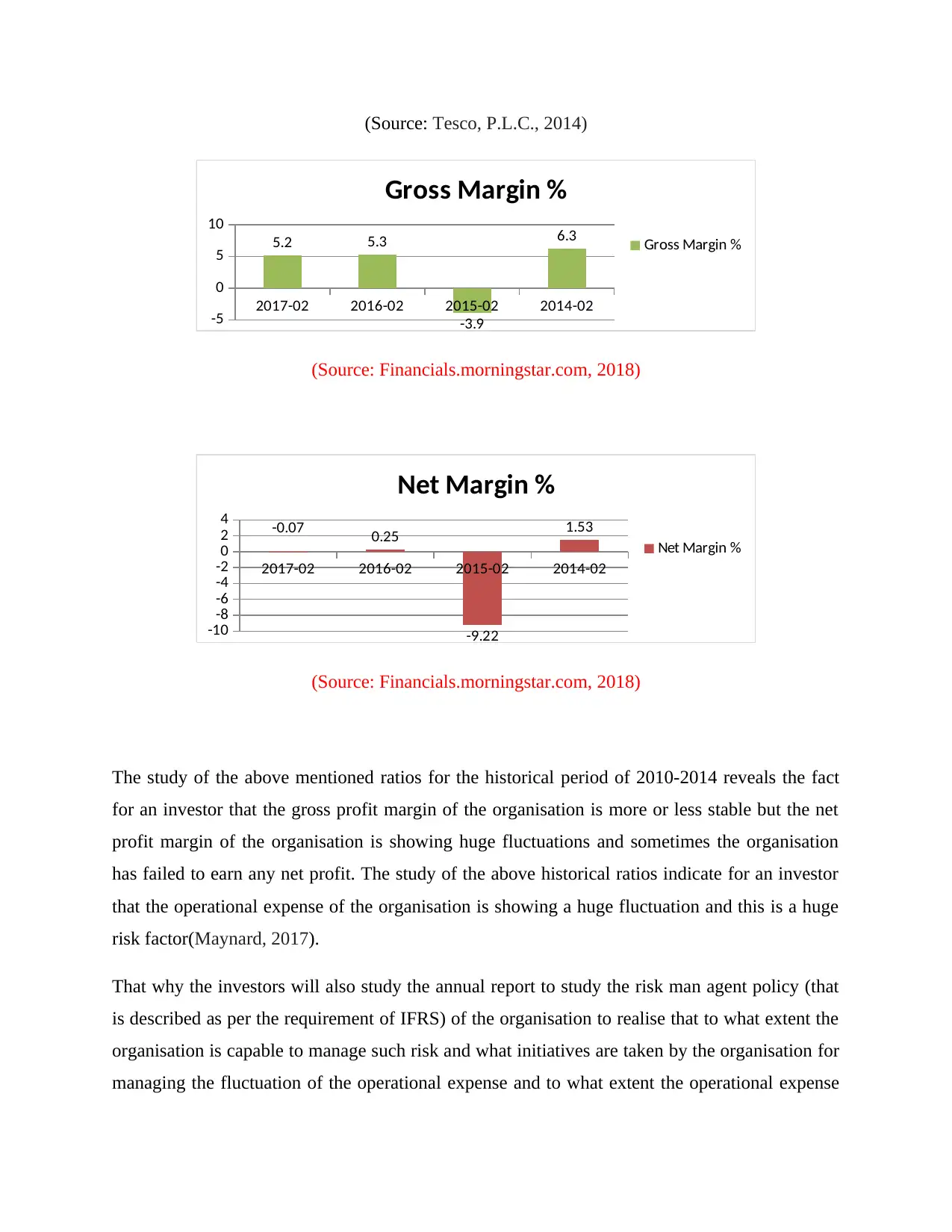
(Source: Tesco, P.L.C., 2014)
2017-02 2016-02 2015-02 2014-02
-5
0
5
10
5.2 5.3
-3.9
6.3
Gross Margin %
Gross Margin %
(Source: Financials.morningstar.com, 2018)
2017-02 2016-02 2015-02 2014-02
-10
-8
-6
-4
-2
0
2
4 -0.07 0.25
-9.22
1.53
Net Margin %
Net Margin %
(Source: Financials.morningstar.com, 2018)
The study of the above mentioned ratios for the historical period of 2010-2014 reveals the fact
for an investor that the gross profit margin of the organisation is more or less stable but the net
profit margin of the organisation is showing huge fluctuations and sometimes the organisation
has failed to earn any net profit. The study of the above historical ratios indicate for an investor
that the operational expense of the organisation is showing a huge fluctuation and this is a huge
risk factor(Maynard, 2017).
That why the investors will also study the annual report to study the risk man agent policy (that
is described as per the requirement of IFRS) of the organisation to realise that to what extent the
organisation is capable to manage such risk and what initiatives are taken by the organisation for
managing the fluctuation of the operational expense and to what extent the operational expense
2017-02 2016-02 2015-02 2014-02
-5
0
5
10
5.2 5.3
-3.9
6.3
Gross Margin %
Gross Margin %
(Source: Financials.morningstar.com, 2018)
2017-02 2016-02 2015-02 2014-02
-10
-8
-6
-4
-2
0
2
4 -0.07 0.25
-9.22
1.53
Net Margin %
Net Margin %
(Source: Financials.morningstar.com, 2018)
The study of the above mentioned ratios for the historical period of 2010-2014 reveals the fact
for an investor that the gross profit margin of the organisation is more or less stable but the net
profit margin of the organisation is showing huge fluctuations and sometimes the organisation
has failed to earn any net profit. The study of the above historical ratios indicate for an investor
that the operational expense of the organisation is showing a huge fluctuation and this is a huge
risk factor(Maynard, 2017).
That why the investors will also study the annual report to study the risk man agent policy (that
is described as per the requirement of IFRS) of the organisation to realise that to what extent the
organisation is capable to manage such risk and what initiatives are taken by the organisation for
managing the fluctuation of the operational expense and to what extent the operational expense
Paraphrase This Document
Need a fresh take? Get an instant paraphrase of this document with our AI Paraphraser
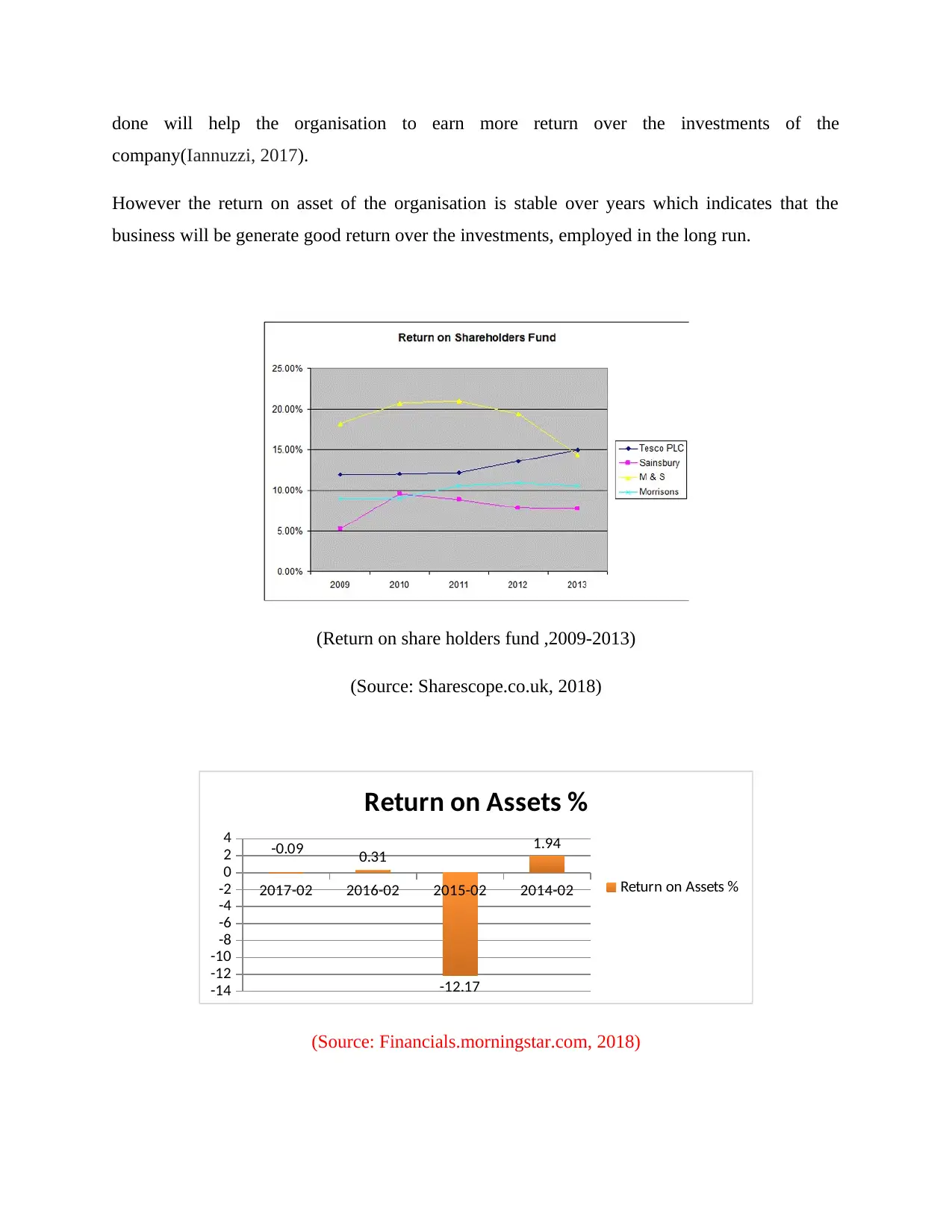
done will help the organisation to earn more return over the investments of the
company(Iannuzzi, 2017).
However the return on asset of the organisation is stable over years which indicates that the
business will be generate good return over the investments, employed in the long run.
(Return on share holders fund ,2009-2013)
(Source: Sharescope.co.uk, 2018)
2017-02 2016-02 2015-02 2014-02
-14
-12
-10
-8
-6
-4
-2
0
2
4 -0.09 0.31
-12.17
1.94
Return on Assets %
Return on Assets %
(Source: Financials.morningstar.com, 2018)
company(Iannuzzi, 2017).
However the return on asset of the organisation is stable over years which indicates that the
business will be generate good return over the investments, employed in the long run.
(Return on share holders fund ,2009-2013)
(Source: Sharescope.co.uk, 2018)
2017-02 2016-02 2015-02 2014-02
-14
-12
-10
-8
-6
-4
-2
0
2
4 -0.09 0.31
-12.17
1.94
Return on Assets %
Return on Assets %
(Source: Financials.morningstar.com, 2018)
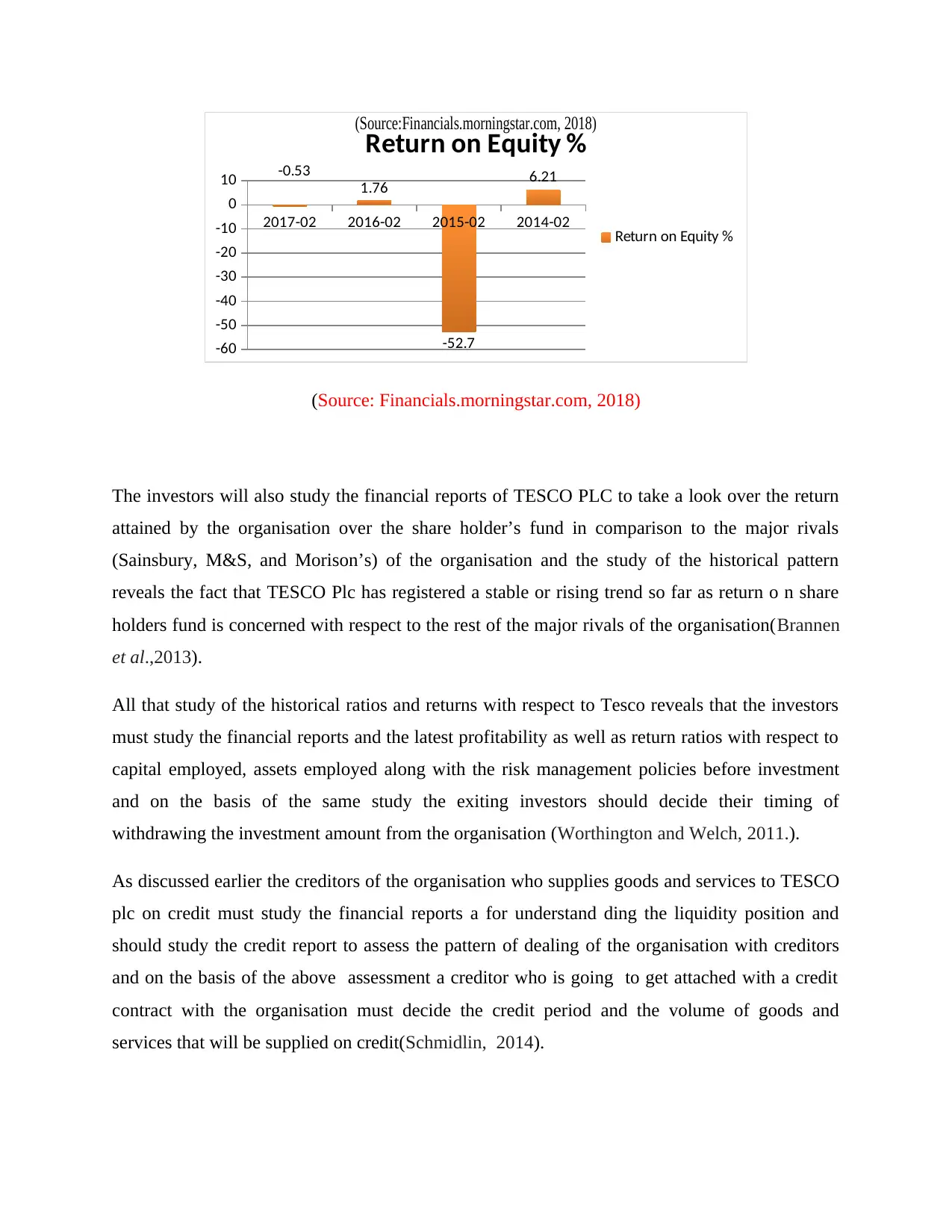
2017-02 2016-02 2015-02 2014-02
-60
-50
-40
-30
-20
-10
0
10 -0.53
1.76
-52.7
6.21
Return on Equity %
Return on Equity %
(Source:Financials.morningstar.com, 2018)
(Source: Financials.morningstar.com, 2018)
The investors will also study the financial reports of TESCO PLC to take a look over the return
attained by the organisation over the share holder’s fund in comparison to the major rivals
(Sainsbury, M&S, and Morison’s) of the organisation and the study of the historical pattern
reveals the fact that TESCO Plc has registered a stable or rising trend so far as return o n share
holders fund is concerned with respect to the rest of the major rivals of the organisation(Brannen
et al.,2013).
All that study of the historical ratios and returns with respect to Tesco reveals that the investors
must study the financial reports and the latest profitability as well as return ratios with respect to
capital employed, assets employed along with the risk management policies before investment
and on the basis of the same study the exiting investors should decide their timing of
withdrawing the investment amount from the organisation (Worthington and Welch, 2011.).
As discussed earlier the creditors of the organisation who supplies goods and services to TESCO
plc on credit must study the financial reports a for understand ding the liquidity position and
should study the credit report to assess the pattern of dealing of the organisation with creditors
and on the basis of the above assessment a creditor who is going to get attached with a credit
contract with the organisation must decide the credit period and the volume of goods and
services that will be supplied on credit(Schmidlin, 2014).
-60
-50
-40
-30
-20
-10
0
10 -0.53
1.76
-52.7
6.21
Return on Equity %
Return on Equity %
(Source:Financials.morningstar.com, 2018)
(Source: Financials.morningstar.com, 2018)
The investors will also study the financial reports of TESCO PLC to take a look over the return
attained by the organisation over the share holder’s fund in comparison to the major rivals
(Sainsbury, M&S, and Morison’s) of the organisation and the study of the historical pattern
reveals the fact that TESCO Plc has registered a stable or rising trend so far as return o n share
holders fund is concerned with respect to the rest of the major rivals of the organisation(Brannen
et al.,2013).
All that study of the historical ratios and returns with respect to Tesco reveals that the investors
must study the financial reports and the latest profitability as well as return ratios with respect to
capital employed, assets employed along with the risk management policies before investment
and on the basis of the same study the exiting investors should decide their timing of
withdrawing the investment amount from the organisation (Worthington and Welch, 2011.).
As discussed earlier the creditors of the organisation who supplies goods and services to TESCO
plc on credit must study the financial reports a for understand ding the liquidity position and
should study the credit report to assess the pattern of dealing of the organisation with creditors
and on the basis of the above assessment a creditor who is going to get attached with a credit
contract with the organisation must decide the credit period and the volume of goods and
services that will be supplied on credit(Schmidlin, 2014).
⊘ This is a preview!⊘
Do you want full access?
Subscribe today to unlock all pages.

Trusted by 1+ million students worldwide
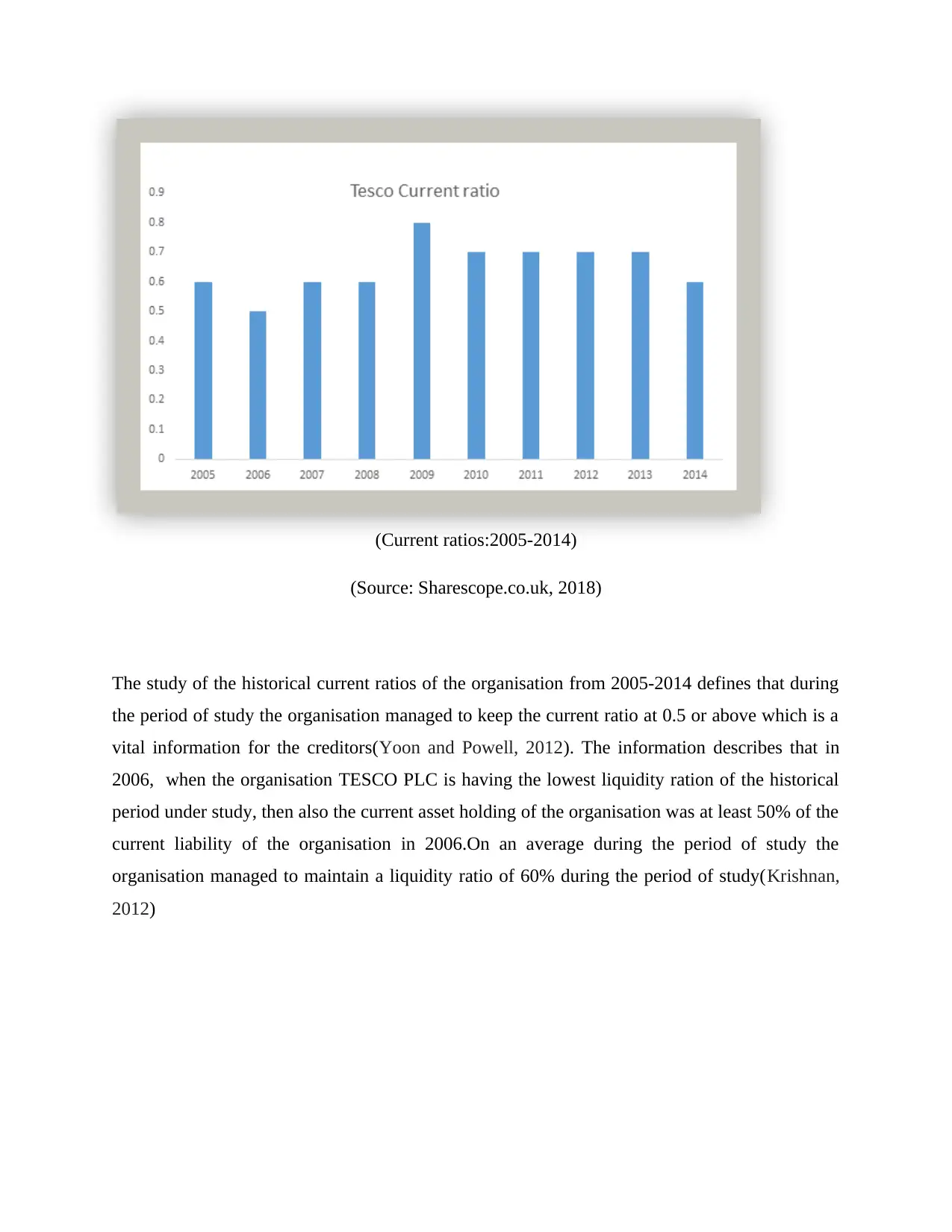
(Current ratios:2005-2014)
(Source: Sharescope.co.uk, 2018)
The study of the historical current ratios of the organisation from 2005-2014 defines that during
the period of study the organisation managed to keep the current ratio at 0.5 or above which is a
vital information for the creditors(Yoon and Powell, 2012). The information describes that in
2006, when the organisation TESCO PLC is having the lowest liquidity ration of the historical
period under study, then also the current asset holding of the organisation was at least 50% of the
current liability of the organisation in 2006.On an average during the period of study the
organisation managed to maintain a liquidity ratio of 60% during the period of study(Krishnan,
2012)
(Source: Sharescope.co.uk, 2018)
The study of the historical current ratios of the organisation from 2005-2014 defines that during
the period of study the organisation managed to keep the current ratio at 0.5 or above which is a
vital information for the creditors(Yoon and Powell, 2012). The information describes that in
2006, when the organisation TESCO PLC is having the lowest liquidity ration of the historical
period under study, then also the current asset holding of the organisation was at least 50% of the
current liability of the organisation in 2006.On an average during the period of study the
organisation managed to maintain a liquidity ratio of 60% during the period of study(Krishnan,
2012)
Paraphrase This Document
Need a fresh take? Get an instant paraphrase of this document with our AI Paraphraser
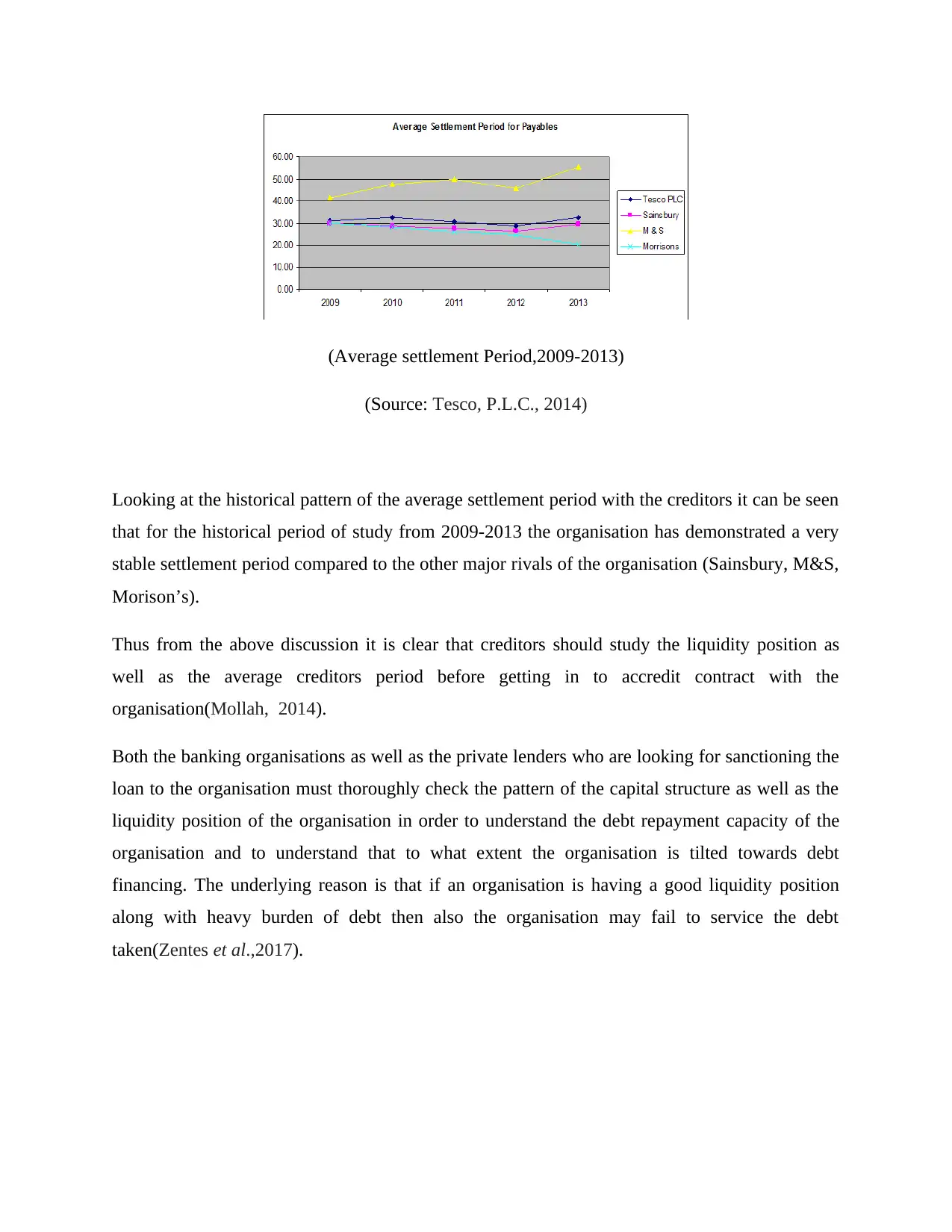
(Average settlement Period,2009-2013)
(Source: Tesco, P.L.C., 2014)
Looking at the historical pattern of the average settlement period with the creditors it can be seen
that for the historical period of study from 2009-2013 the organisation has demonstrated a very
stable settlement period compared to the other major rivals of the organisation (Sainsbury, M&S,
Morison’s).
Thus from the above discussion it is clear that creditors should study the liquidity position as
well as the average creditors period before getting in to accredit contract with the
organisation(Mollah, 2014).
Both the banking organisations as well as the private lenders who are looking for sanctioning the
loan to the organisation must thoroughly check the pattern of the capital structure as well as the
liquidity position of the organisation in order to understand the debt repayment capacity of the
organisation and to understand that to what extent the organisation is tilted towards debt
financing. The underlying reason is that if an organisation is having a good liquidity position
along with heavy burden of debt then also the organisation may fail to service the debt
taken(Zentes et al.,2017).
(Source: Tesco, P.L.C., 2014)
Looking at the historical pattern of the average settlement period with the creditors it can be seen
that for the historical period of study from 2009-2013 the organisation has demonstrated a very
stable settlement period compared to the other major rivals of the organisation (Sainsbury, M&S,
Morison’s).
Thus from the above discussion it is clear that creditors should study the liquidity position as
well as the average creditors period before getting in to accredit contract with the
organisation(Mollah, 2014).
Both the banking organisations as well as the private lenders who are looking for sanctioning the
loan to the organisation must thoroughly check the pattern of the capital structure as well as the
liquidity position of the organisation in order to understand the debt repayment capacity of the
organisation and to understand that to what extent the organisation is tilted towards debt
financing. The underlying reason is that if an organisation is having a good liquidity position
along with heavy burden of debt then also the organisation may fail to service the debt
taken(Zentes et al.,2017).
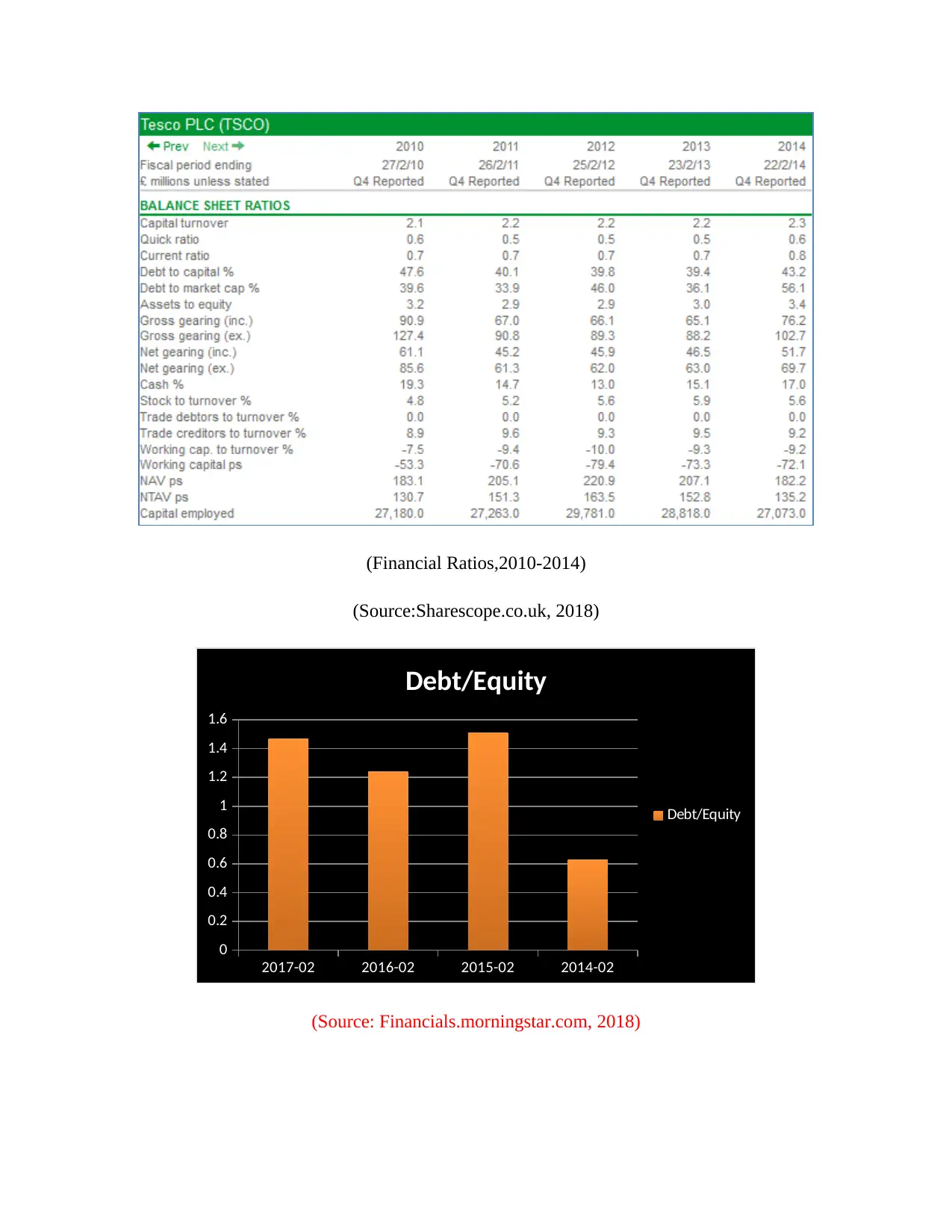
(Financial Ratios,2010-2014)
(Source:Sharescope.co.uk, 2018)
2017-02 2016-02 2015-02 2014-02
0
0.2
0.4
0.6
0.8
1
1.2
1.4
1.6
Debt/Equity
Debt/Equity
(Source: Financials.morningstar.com, 2018)
(Source:Sharescope.co.uk, 2018)
2017-02 2016-02 2015-02 2014-02
0
0.2
0.4
0.6
0.8
1
1.2
1.4
1.6
Debt/Equity
Debt/Equity
(Source: Financials.morningstar.com, 2018)
⊘ This is a preview!⊘
Do you want full access?
Subscribe today to unlock all pages.

Trusted by 1+ million students worldwide
1 out of 17
Related Documents
Your All-in-One AI-Powered Toolkit for Academic Success.
+13062052269
info@desklib.com
Available 24*7 on WhatsApp / Email
![[object Object]](/_next/static/media/star-bottom.7253800d.svg)
Unlock your academic potential
Copyright © 2020–2025 A2Z Services. All Rights Reserved. Developed and managed by ZUCOL.




